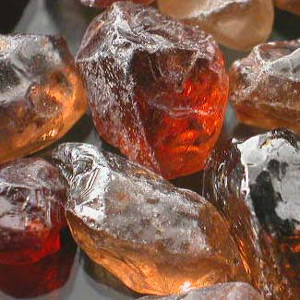 chromium3+ ions. Each Cr3+ is surrounded octahedrally by six O2- ions. This crystallographic arrangement strongly affects each Cr3+, resulting in light absorption in the yellow-green region of the spectrum and thus in the red color of the gem. When yellow-green light is absorbed by Cr3+, it is re-emitted as red luminescence.
chromium3+ ions. Each Cr3+ is surrounded octahedrally by six O2- ions. This crystallographic arrangement strongly affects each Cr3+, resulting in light absorption in the yellow-green region of the spectrum and thus in the red color of the gem. When yellow-green light is absorbed by Cr3+, it is re-emitted as red luminescence. This red emission adds to the red colour perceived by the subtraction of green and violet light from white light, and adds luster to the gem's appearance. When the optical arrangement is such that the emission is stimulated by 694-nanometer photons reflecting back and forth between two mirrors, the emission grows strongly in intensity. This effect was used by Theodore Maiman in 1960 to make the first successful laser, based on ruby. All natural rubies have imperfections in them, including color impurities and inclusions of rutile needles known as "silk". Gemologists use these needle inclusions found in natural rubies to distinguish them from synthetics, simulants, or substitutes. Usually the rough stone is heated before cutting. Almost all rubies today are treated in some form, with heat treatment being the most common practice. However, rubies that are completely untreated but still of excellent quality command a large premium. Some rubies show a 3-point or 6-point asterism or "star".
These rubies are cut into cabochons to display the effect properly. Asterisms are best visible with a single-light source, and move across the stone as the light moves or the stone is rotated. Such effects occur when light is reflected off the "silk" (the structurally oriented rutile needle inclusions) in a certain way. This is one example where inclusions increase the value of a gemstone. Furthermore, rubies can show color changes — though this occurs very rarely — as well as chatoyancy or the "cat's eye" effect This article is about the mineral. For other uses, see Ruby (disambiguation). Ruby Natural ruby crystals from Winza, Tanzania General Category Mineral variety Ch
 emical formula aluminium oxide with chromium, Al2O3:Cr Identification Color Red, may be brownish, purplish or pinkish Crystal habit Varies with locality. Terminated tabular hexagonal prisms. Crystal system Trigonal (Hexagonal Scalenohedral) Symbol (−3 2/m) Space Group: R-3c Cleavage No true cleavage Fracture Uneven or conchoidal Mohs scale hardness 9.0 Luster Vitreous Streak white Diaphaneity transparent Specific gravity 4.0 Refractive index nω=1.768 – 1.772 nε=1.760 – 1.763, Birefringence 0.008 Pleochroism Orangey red, purplish red Ultraviolet fluorescence red under longwave Melting point 2044 °C Solubility none Major varieties Sapphire Any color except red Corundum various colors Emery Granular A ruby is a pink to blood-red colored gemstone, a variety of the mineral corundum (aluminium oxide).
emical formula aluminium oxide with chromium, Al2O3:Cr Identification Color Red, may be brownish, purplish or pinkish Crystal habit Varies with locality. Terminated tabular hexagonal prisms. Crystal system Trigonal (Hexagonal Scalenohedral) Symbol (−3 2/m) Space Group: R-3c Cleavage No true cleavage Fracture Uneven or conchoidal Mohs scale hardness 9.0 Luster Vitreous Streak white Diaphaneity transparent Specific gravity 4.0 Refractive index nω=1.768 – 1.772 nε=1.760 – 1.763, Birefringence 0.008 Pleochroism Orangey red, purplish red Ultraviolet fluorescence red under longwave Melting point 2044 °C Solubility none Major varieties Sapphire Any color except red Corundum various colors Emery Granular A ruby is a pink to blood-red colored gemstone, a variety of the mineral corundum (aluminium oxide). The red color is caused mainly by the presence of the element chromium. Its name comes from ruber, Latin for red. Other varieties of gem-quality corundum are called sapphires. The ruby is considered one of the four precious stones, together with the sapphire, the emerald, and the diamond. Prices of rubies are primarily determined by color. The brightest and most valuable "red" called pigeon blood-red, commands a huge premium over other rubies of similar quality. After color follows clarity: similar to diamonds, a clear stone will command a premium, but a ruby without any needle-like rutile inclusions may indicate that the stone has been treated. Cut and carat (weight) are also an important factor in determining the price http://en.wikipedia.org/wiki/Ruby








